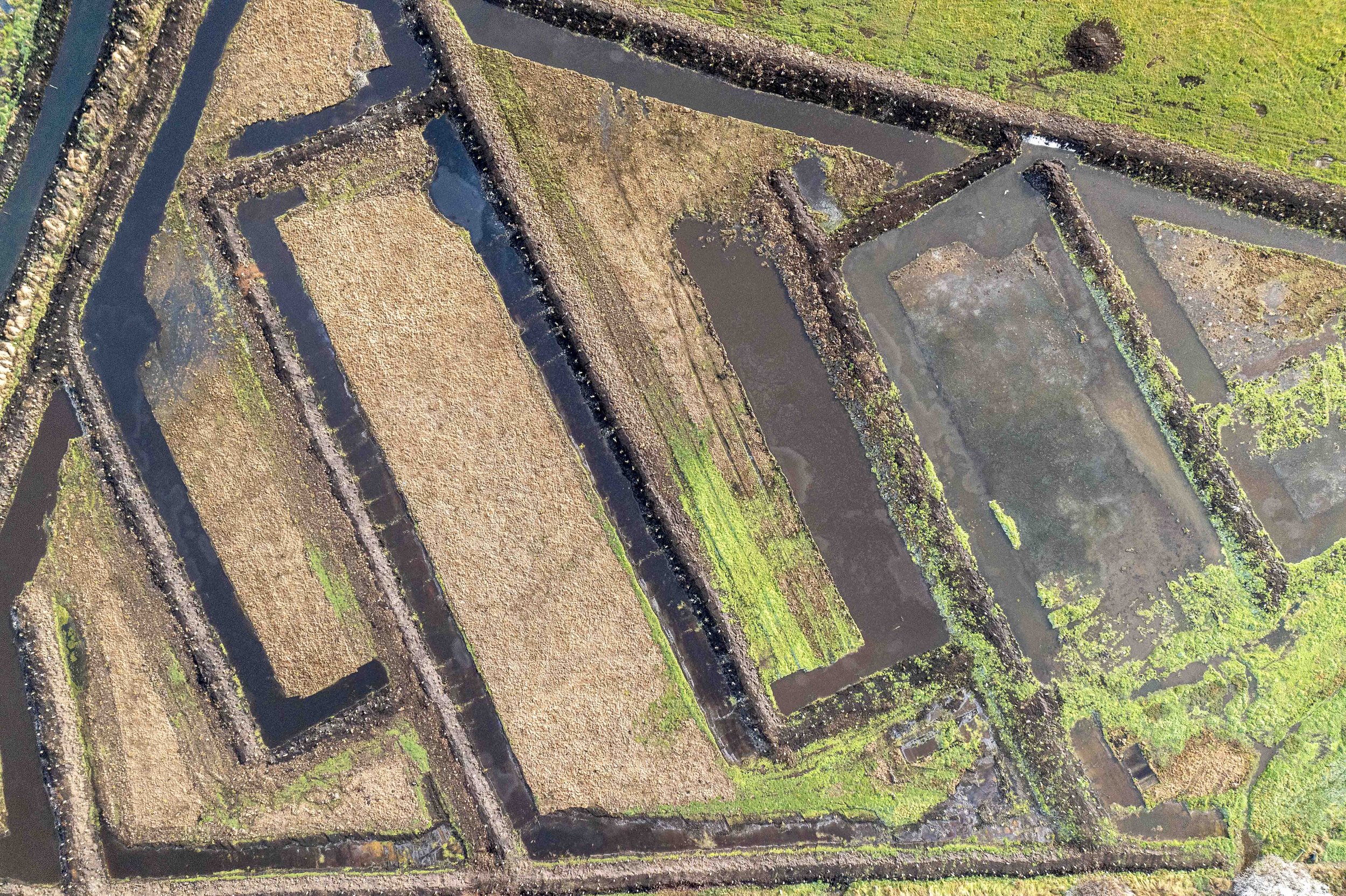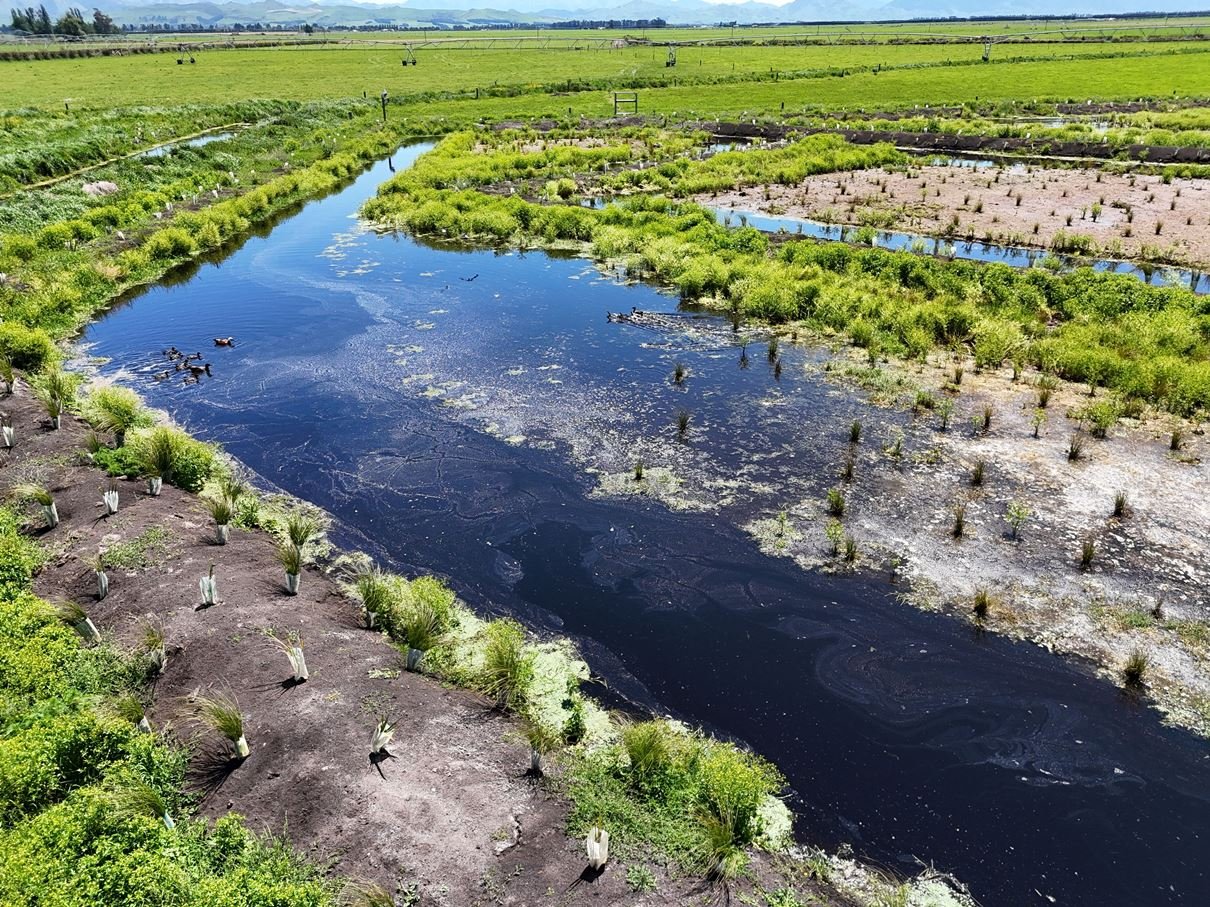
The Delany Wetland
An Amuri Basin Future Farming Project Pilot
A pilot programme is helping us determine if constructed wetlands could be implemented more widely in the Amuri Basin as an effective long-term solution to water quality issues. A four-year NIWA study has found that constructed wetlands can replicate natural systems to remove nitrate leaching from dairy farm pastures. Building on these findings, AIC’s pilot project aims to measure the impact of a wetland on water flowing into St Leonards Drain, a waterway with nitrogen concentrations five times the national standard. The trial is an important step in assessing the viability and effectiveness of wetland restoration in the Amuri Basin. Success will provide a template for future projects, enhancing our understanding of scalability, costs, perfomance, ecological values and biodiversity benefits.
At a Glance:
1.6 hectares of pasture restored
4,800 natives planted
60 samples tested per year
Five water monitoring sites
200mm average depth
Project Timeline
-
Sept 2023 >
Initial investigations and site selection
-
Feb 2024 >
Site establishment and earthworks
-
May 2024 >
Trees, flaxes and grasses planted
-
Aug 2024 >
First round of water testing
-
Sept 2024 >
Investigations into further wetland sites
-
Nov 2024 >
Site fully inundated with water
The Trial Site
Several potential sites with groundwater upwelling were considered, with the final selection based on replicability, low construction and maintenance costs, and suitable soil conditions. Approximately 1.6 hectares of pasture on Jerseyland Dairies in Culverden was eventually selected for the trial site. It has the ideal peaty soil layer over a clay base – the clay slows drainage, ensuring water stays in the wetland long enough for effective treatment. Proximity to two natural wetland features provides advantages for biodiversity and functionality.
Site History
The trial site is located on an operational dairy farm, adjacent to grazing paddocks and farm access tracks. Landowners Tim and Jo Delany explain they had already retired the surrounding natural wetland areas. Historical survey maps from the 1860s suggest that the site was part of a natural wetland, one of several drained during land development in the Basin in the early 1900s. The concept of a treatment wetland fits into the farm philosophy to restore biodiversity and natural function of the land.
The Design
Designed and built by Shane Dwyer of Dwyer Lewis Earthworks, with scientific oversight by Dr Peter Brown (PZB Civil and Environmental Engineering), Dr Lee Burbery (DairyNZ), and Brian Ellwood (Lowe Environmental), the trial has employed a ‘minimally constructed’ approach. The land was contoured into a serpentine system to reverse drainage and create conditions for slow water flow across the wetland, promoting maximum attenuation - allowing sediments to settle and contaminants to be removed through adhesion to vegetation and anaerobic decomposition.
Riparian Restoration
Totara and Kowhai trees, along with native flaxes, grasses and shrubs from Synlait Milk’s industrial nursery Whakapuāwai, were planted by Hurunui Natives with support from Te Rūnanga o Kaikōura. Seeds collected from an nearby wetland are being raised in Synlait’s nursery and will be reintroduced to the site in late 2025 to enhance nutrient uptake. A total of 4,800 specimens have been planted in and around the wetland. Water flow into the site has been temporarily reduced to allow the plants to take root and establish properly.
“It takes time for the soil to build up nitrate-breaking bacteria, but early results are promising, as indicated by the oily sheen of bacterial activity on the water surface.”
-Mike Hennessy, AIC’s Environmental Projects Lead
Monitoring
A full suite of water quality tests is conducted monthly at five monitoring sites across the wetland. The first round of sampling, completed in August 2024, revealed a substantial reduction in nitrate levels. While this initial result is promising, it's essential to base our conclusions on a robust set of statistically significant data. We look forward to sharing the wetland's performance as more data becomes available.
Enhancing Biodiversity
As the water levels rise, so too does the biodiversity. We’ve already enjoyed the lively chorus of frogs, witnessed native tuna (freshwater eel) swimming leisurely through the waters, and been treated to a stunning dawn chorus from the growing number of bird species calling the wetland home. It’s very pleasing to see the wetland flourishing and supporting diverse wildlife.
Play the video recorded by our wetland camera to hear the frogs!
Progress Images
September 2025 - The wetland continues to prove what is possible with ongoing positive monitoring results.
May 2025 - A lot of rain at the start of the month left much of the wetland underwater.
April 2025 - To the bottom right, a new weir has been installed to measure water flow out of the wetland.
March 2025 - The planted Carex have now reached a metre in height.
February 2025 - The plantings along the banks of the wetland are thriving.
January 2025 - A breeding pair of stilts with their chick were spotted making themselves at home.
December 2024 - The site was fully commissioned on 16 December.
November 2024 - Signs of increasing biodiversity are evident - birdsong, frog chorus and even a couple of Tuna, NZ freshwater eel, spotted.
October 2024 - Heavy rain flooded the wetland and surrounding area for a period of time.
September 2024 - The plantings are growing but so are the weeds - weed control is planned to take place in October.
August 2024 - The first round of water samples are taken.
July 2024 - The water level slowly rises naturally.
June 2024 - The plantings are left to establish over winter. An oily sheen of bacterial activity is visible on the water.
May 2024 - The site is planted out in 4,800 native trees, shrubs, flaxes and grasses.
March 2024 - The serpertine construction of the wetland takes shape.
March 2024 - Earthworks commenced.
November 2023 - Site design and contractor engagement was well underway.
October 2019 - The site had been identified as one of several with considerable groundwater welling.
What’s Next? The site was fully commissioned in December 2024. The wetland will be left to function naturally, fulfilling its intended role and, hopefully, continuing to improve water quality. Meanwhile, investigations are underway for the development of two additional wetlands, with one site showing particularly strong potential.
Who can I contact about the Project?
-

Mike Hennessy
ENVIRONMENTAL PROJECTS LEAD
027 7066 787




















